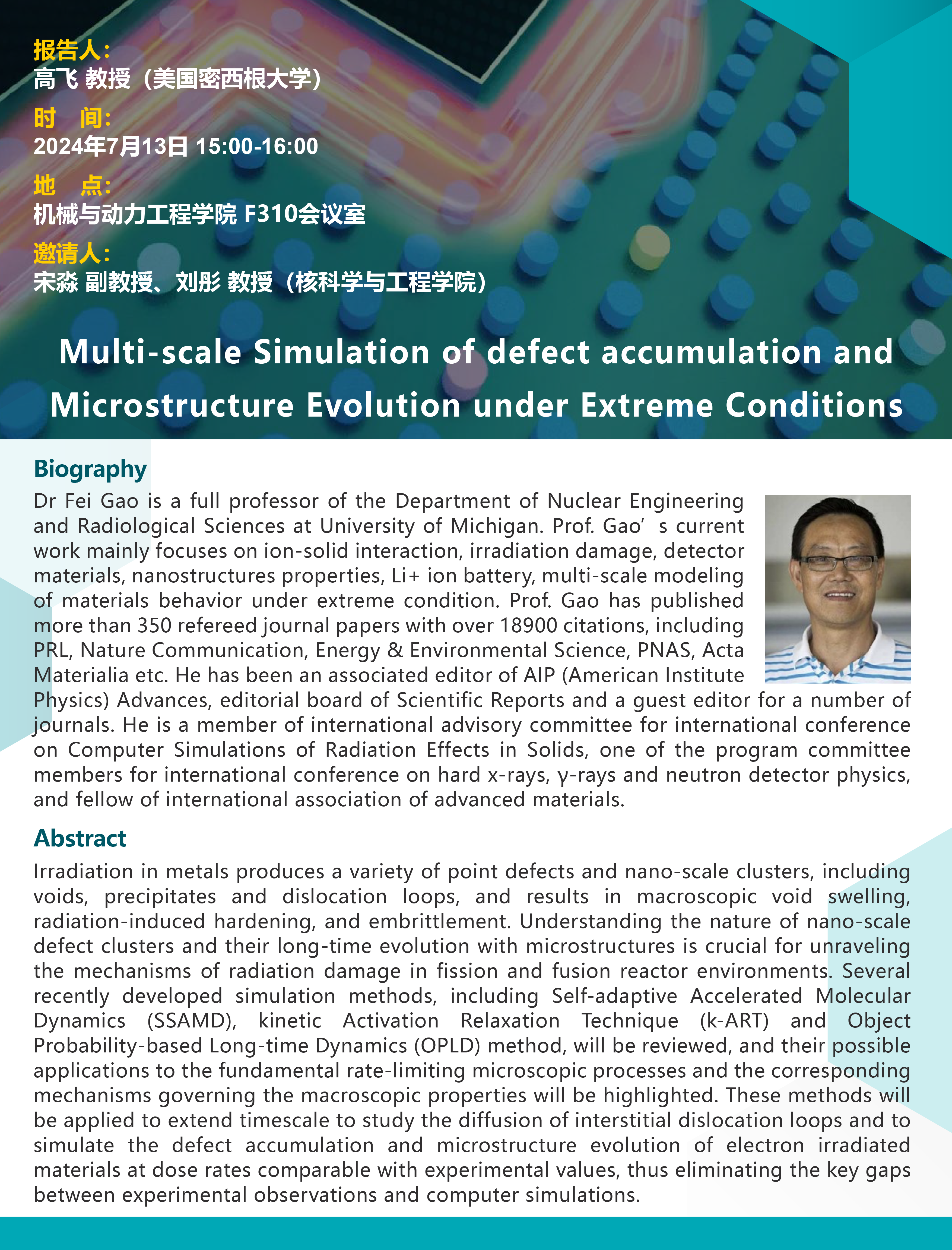

题目:Multi-scale Simulation of defect accumulation and Microstructure Evolution under Extreme Conditions
时间:2024年7月13日 15:00-16:00
地点:hga010网页登录 F310会议室
邀请人:宋淼 副教授、刘彤 教授(核科学与工程学院)
Biography
 Dr Fei Gao is a full professor of the Department of Nuclear Engineering and Radiological Sciences at University of Michigan. Prof. Gao’s current work mainly focuses on ion-solid interaction, irradiation damage, detector materials, nanostructures properties, Li+ ion battery, multi-scale modeling of materials behavior under extreme condition. Prof. Gao has published more than 350 refereed journal papers with over 18900 citations, including PRL, Nature Communication, Energy & Environmental Science, PNAS, Acta Materialia etc. He has been an associated editor of AIP (American Institute Physics) Advances, editorial board of Scientific Reports and a guest editor for a number of journals. He is a member of international advisory committee for international conference on Computer Simulations of Radiation Effects in Solids, one of the program committee members for international conference on hard x-rays, γ-rays and neutron detector physics, and fellow of international association of advanced materials.
Dr Fei Gao is a full professor of the Department of Nuclear Engineering and Radiological Sciences at University of Michigan. Prof. Gao’s current work mainly focuses on ion-solid interaction, irradiation damage, detector materials, nanostructures properties, Li+ ion battery, multi-scale modeling of materials behavior under extreme condition. Prof. Gao has published more than 350 refereed journal papers with over 18900 citations, including PRL, Nature Communication, Energy & Environmental Science, PNAS, Acta Materialia etc. He has been an associated editor of AIP (American Institute Physics) Advances, editorial board of Scientific Reports and a guest editor for a number of journals. He is a member of international advisory committee for international conference on Computer Simulations of Radiation Effects in Solids, one of the program committee members for international conference on hard x-rays, γ-rays and neutron detector physics, and fellow of international association of advanced materials.
Abstract
Irradiation in metals produces a variety of point defects and nano-scale clusters, including voids, precipitates and dislocation loops, and results in macroscopic void swelling, radiation-induced hardening, and embrittlement. Understanding the nature of nano-scale defect clusters and their long-time evolution with microstructures is crucial for unraveling the mechanisms of radiation damage in fission and fusion reactor environments. Several recently developed simulation methods, including Self-adaptive Accelerated Molecular Dynamics (SSAMD), kinetic Activation Relaxation Technique (k-ART) and Object Probability-based Long-time Dynamics (OPLD) method, will be reviewed, and their possible applications to the fundamental rate-limiting microscopic processes and the corresponding mechanisms governing the macroscopic properties will be highlighted. These methods will be applied to extend timescale to study the diffusion of interstitial dislocation loops and to simulate the defect accumulation and microstructure evolution of electron irradiated materials at dose rates comparable with experimental values, thus eliminating the key gaps between experimental observations and computer simulations.
